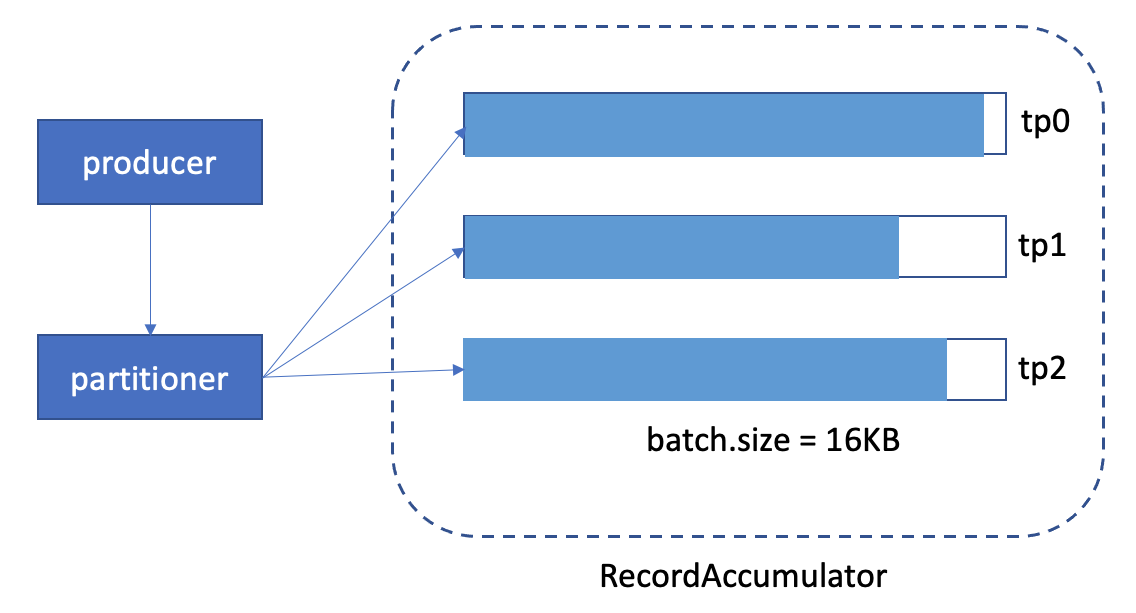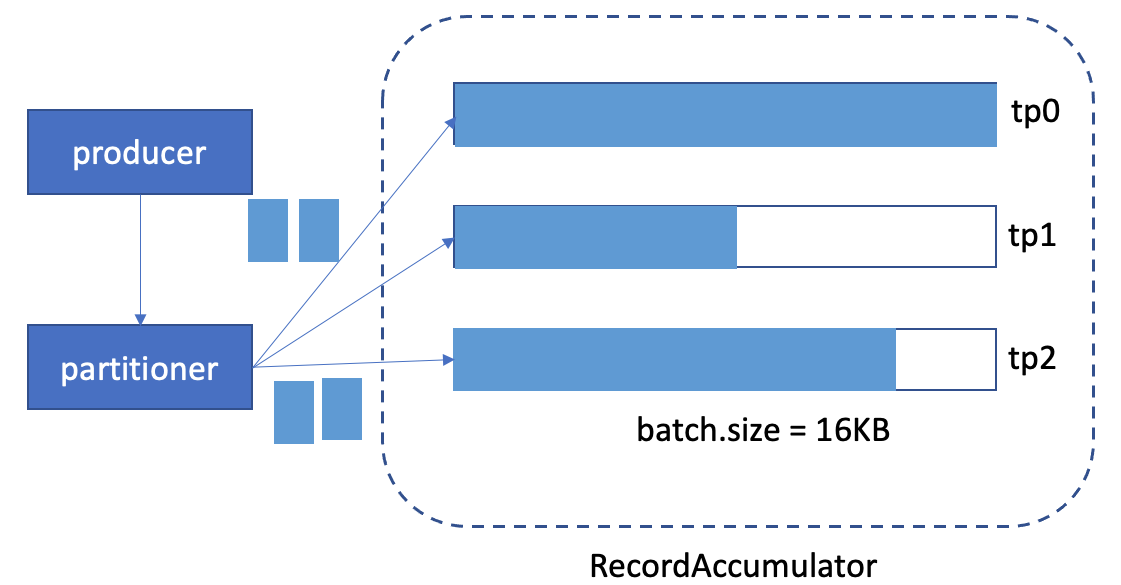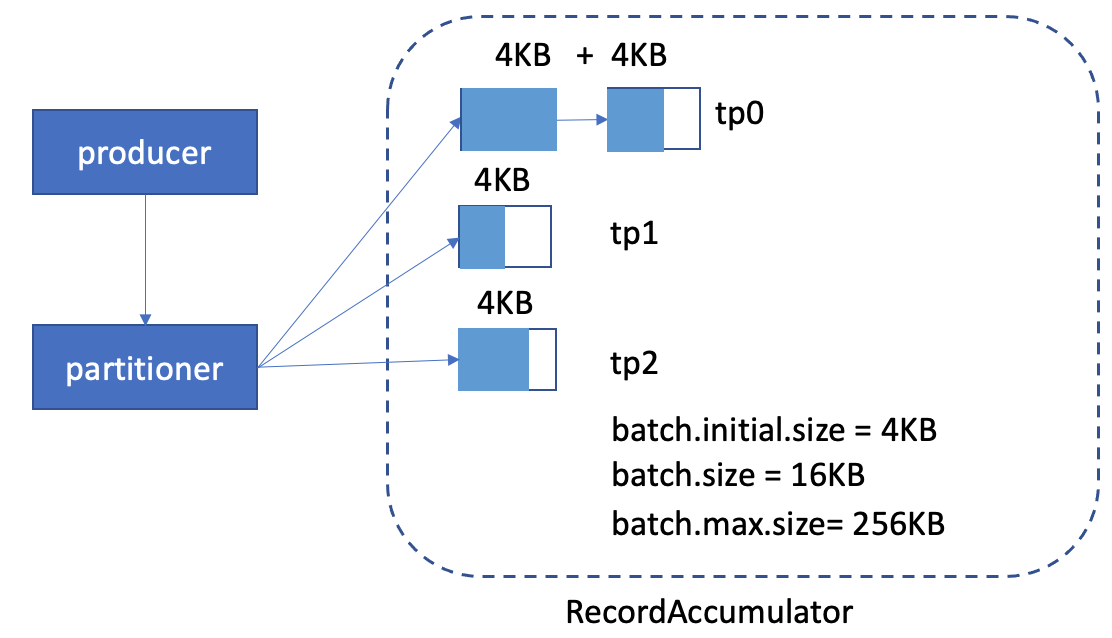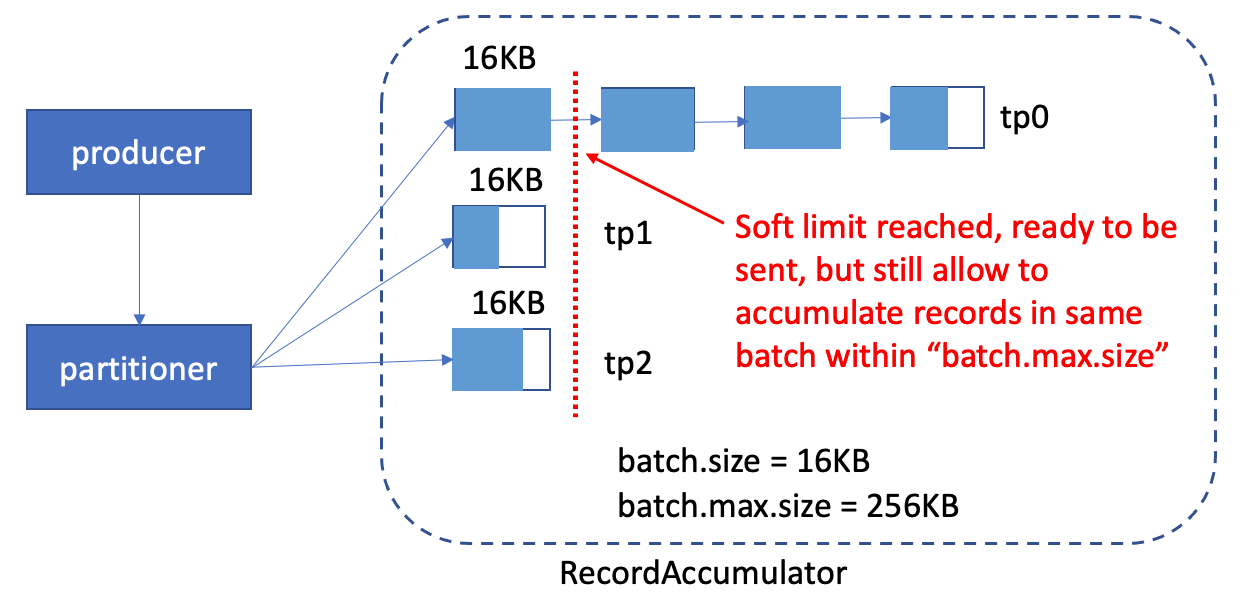Status
Current state: "Under Discussion"
Discussion thread: here
JIRA: here
Please keep the discussion on the mailing list rather than commenting on the wiki (wiki discussions get unwieldy fast).
Motivation
Kafka provides high throughput in each component. In the producer, there are 2 key configs to support the high throughput:
- batch.size: it specifies a maximum batch size in bytes per partition (default 16384)
- linger.ms: it specifies a maximum duration to fill the batch in milliseconds (default 0 or no delay)
Records are sent until either of above 2 thresholds are reached.
The high level component diagram is like this:
However, when we set the batch size, we'll run into a dilemma:
- either we have higher throughput + more memory waste,
- or we have slower throughput + less memory waste.
Why is that?
We can check the description for "batch.size" in documentation here. Here's the last paragraph I extracted from the document:
A small batch size will make batching less common and may reduce throughput (a batch size of zero will disable batching entirely). A very large batch size may use memory a bit more wastefully as we will always allocate a buffer of the specified batch size in anticipation of additional records.
That explains why we have the dilemma when setting this config.
Use the above example, we set the "batch.size" as default 16KB.
1. off-peak time, the graph might look like this(when linger.ms expired):
We can see, the memory usage is very low.
2. peak time, the graph might look like this:
We can see, the batch is full, and need to create new batch for it and send out this batch soon.
In the peak-time case, when we notice this situation, we might want to increase the batch size for it, let's say, increase from 16KB to 20KB. But when we increase the batch.size, we know all batches will be allocate with 20KB from now on, even it's off-peak time (check case 1). That's wasteful.
Furthermore, currently batch.size is used in two conditions:
1. When we append records to a batch in the accumulator, we create a new batch if the current batch would exceed the batch.size.
2. When we drain the batch from the accumulator, a batch becomes 'ready' when it reaches batch.size.
The second condition is good with the current batch size, because if linger.ms is greater than 0, the send can be triggered by accomplishing the
batching goal.
The first condition, though, leads to creating many batches if the network latency or production rate (or both) is high, and with 5 in-flight and 16KB batches we can only have 80KB of data in-flight per partition. Which means that with 50ms latency, we can only push ~1.6MB/sec per partition (this goes down if we consider higher latencies, e.g. with 100ms we can only push ~0.8MB/sec).
In this KIP, I'm going to introduce a dynamic expandable buffer size for producer, with a larger allowable batch size (i.e. "batch.max.size").
Public Interfaces
2 Producer config will be introduced:
- batch.initial.size: It specifies the initial batch size when new batch created (default is 0(disabled), which means we'll always allocate "batch.size" buffer and no buffer expansion will happen)
- batch.max.size: It specifies the maximum batch size in bytes per partition, it should be less than "max.request.size". ("batch.max.size" default to 262144(256KB))
To have a better memory usage, the relation of the configurations should be:
- "batch.size" = "batch.initial.size" * n (n means the times we expansion)
- "batch.max.size" = "batch.initial.size" * n (n means the times we expansion)
ex:
1. "batch.size" = 16KB, "batch.initial.size" = 2KB
=> 16KB = 2KB * 8
2. "batch.size" = 16KB, "batch.initial.size" = 0 (default, disabled), "batch.max.size" = 256KB
=> 256KB = 16KB * 16
Proposed Changes
We'll allocate the "batch.initial.size" (default disabled, which will use "batch.size" as initial batch size) memory when new records send to an empty partition buffer. While we accumulated more records in the partitions to reach the "batch.initial.size" (ex: 2KB), we'll do buffer expansion to allocate another "batch.initial.size" of buffer and list with the previous buffer. And then, keeps accumulating the records.
When reaching the "batch.size" of the buffer, it means the buffer is "ready" to be be sent. But before the sender thread is ready to send the batch, if there are more data coming, we can still accumulate it into the same buffer, until it reached the "batch.max.size". After it reached the "batch.max.size", we'll create another batch for it.
So, let's see the 2 cases above
1. off-peak time
We can see now, the memory usage is still high, because we allocate batch.initial.size(4KB) each chunk.
2. peak-time
With the batch.max.size config introduced, we can have a larger amount of batch before the sender thread is ready to send the batch, to achieve high throughput.
Compatibility, Deprecation, and Migration Plan
Because the "batch.initial.size" default value is 0(disabled), which means we'll always allocate "batch.size" buffer and no buffer expansion will happen, there will be always backward compatible. And the "batch.max.size" is transient to users. So no migration plan is needed.
Rejected Alternatives
N/A




